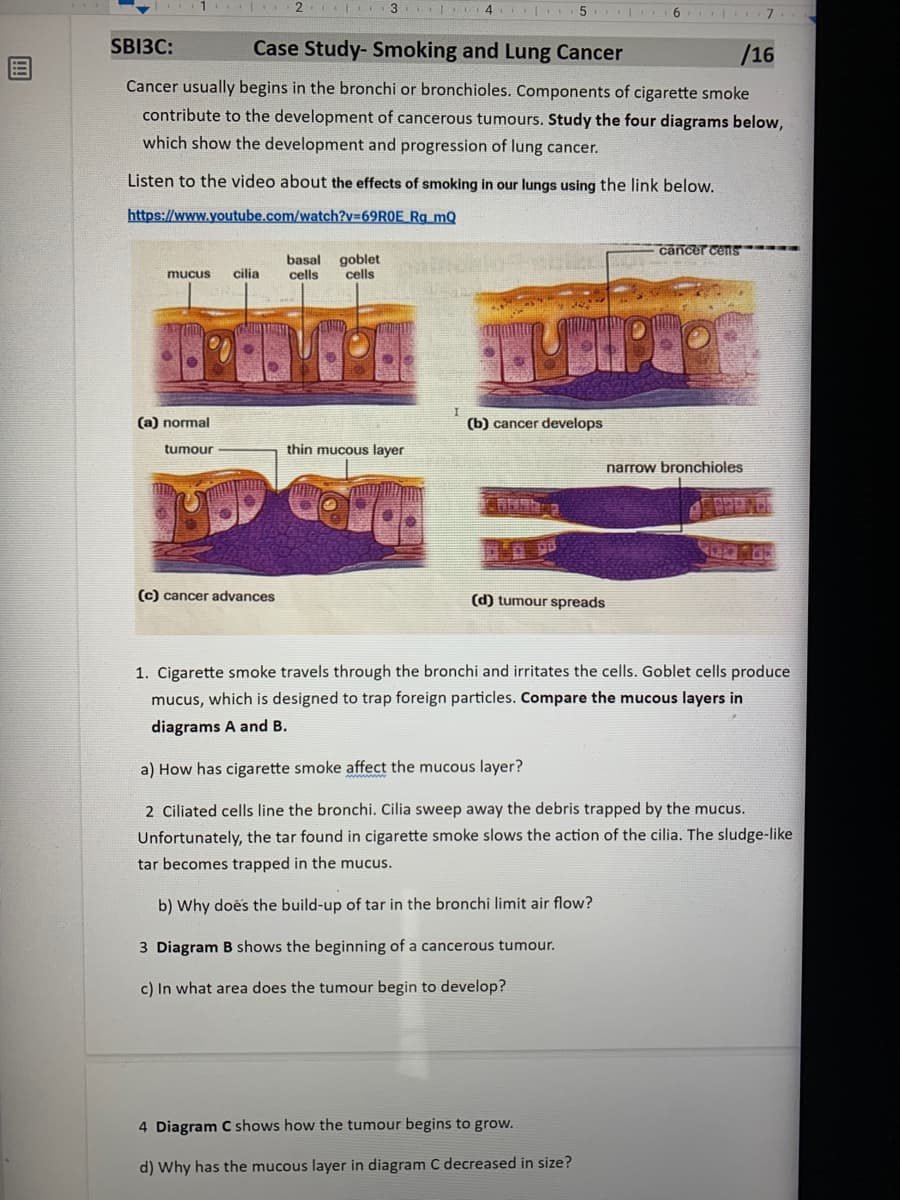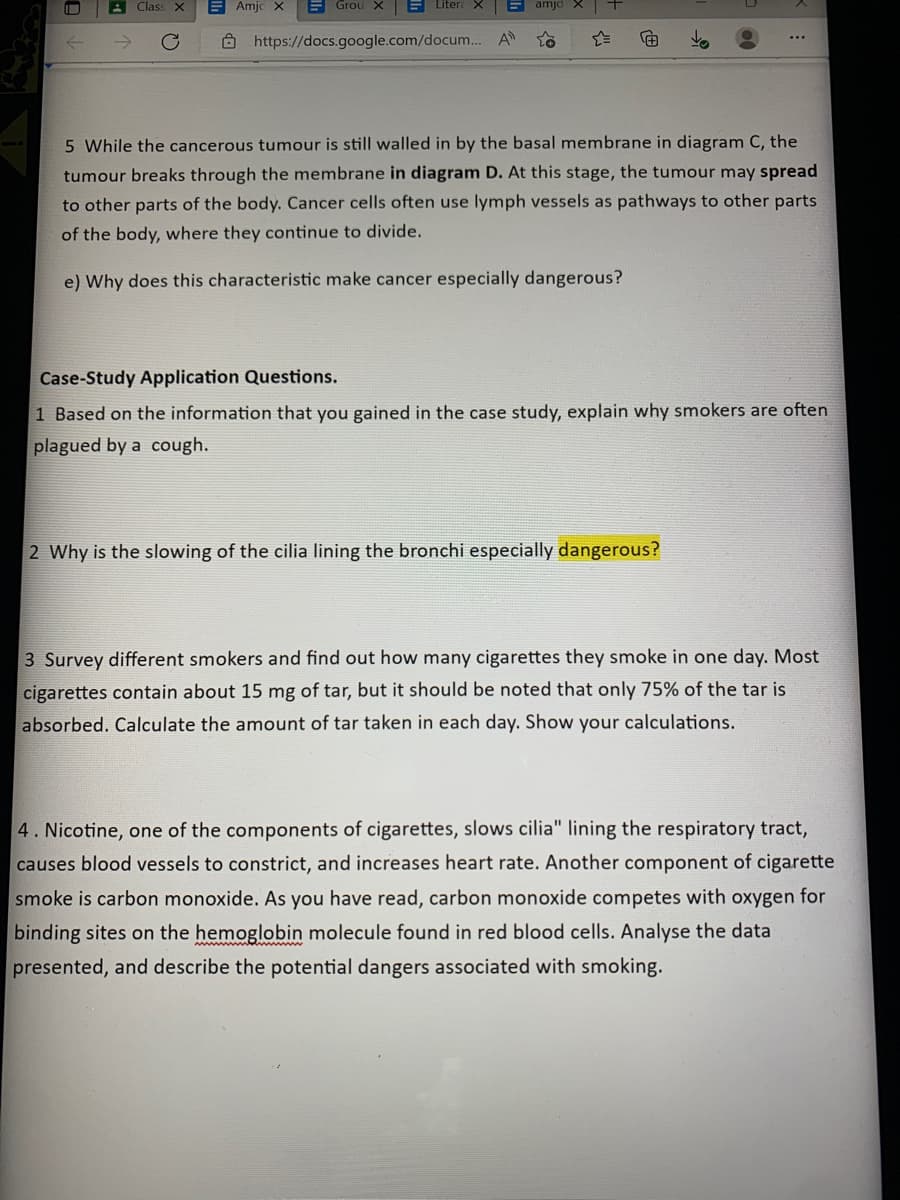Cancer usually begins in the bronchi or bronchioles. Components of cigarette smoke contribute to the development of cancerous tumours. Study the four diagrams below, which show the development and progression of lung cancer. Listen to the video about the effects of smoking in our lungs using the link below. https://www.youtube.com/watch?v=69ROE_Rg_mQ cancer cens basal goblet cells cells mucus cilia (a) normal (b) cancer develops tumour thin mucous layer narrow bronchioles (c) cancer advances (d) tumour spreads 1. Cigarette smoke travels through the bronchi and irritates the cells. Goblet cells produce mucus, which is designed to trap foreign particles. Compare the mucous layers in diagrams A and B. a) How has cigarette smoke affect the mucous layer? 2 Ciliated cells line the bronchi. Cilia sweep away the debris trapped by the mucus. Unfortunately, the tar found in cigarette smoke slows the action of the cilia. The sludge-like. tar becomes trapped in the mucus. b) Why does the build-up of tar in the bronchi limit air flow? 3 Diagram B shows the beginning of a cancerous tumour. c) In what area does the tumour begin to develop?
Cancer usually begins in the bronchi or bronchioles. Components of cigarette smoke contribute to the development of cancerous tumours. Study the four diagrams below, which show the development and progression of lung cancer. Listen to the video about the effects of smoking in our lungs using the link below. https://www.youtube.com/watch?v=69ROE_Rg_mQ cancer cens basal goblet cells cells mucus cilia (a) normal (b) cancer develops tumour thin mucous layer narrow bronchioles (c) cancer advances (d) tumour spreads 1. Cigarette smoke travels through the bronchi and irritates the cells. Goblet cells produce mucus, which is designed to trap foreign particles. Compare the mucous layers in diagrams A and B. a) How has cigarette smoke affect the mucous layer? 2 Ciliated cells line the bronchi. Cilia sweep away the debris trapped by the mucus. Unfortunately, the tar found in cigarette smoke slows the action of the cilia. The sludge-like. tar becomes trapped in the mucus. b) Why does the build-up of tar in the bronchi limit air flow? 3 Diagram B shows the beginning of a cancerous tumour. c) In what area does the tumour begin to develop?
Chapter9: A Breath Of Fresh Air
Section: Chapter Questions
Problem 1M
Related questions
Question
This is the link from the picture
https://www.youtube.com/watch?v=69R0E_Rg_mQ

Transcribed Image Text:1 2 3 4
51. 6
SBI3C:
Case Study- Smoking and Lung Cancer
/16
Cancer usually begins in the bronchi or bronchioles. Components of cigarette smoke
contribute to the development of cancerous tumours. Study the four diagrams below,
which show the development and progression of lung cancer.
Listen to the video about the effects of smoking in our lungs using the link below.
https://www.youtube.com/watch?v=69ROE_Rg_mQ
cancer cens
basal goblet
cells cells
mucus cilia
(a) normal
(b) cancer develops
tumour
thin mucous layer
narrow bronchioles
(c) cancer advances
(d) tumour spreads
1. Cigarette smoke travels through the bronchi and irritates the cells. Goblet cells produce
mucus, which is designed to trap foreign particles. Compare the mucous layers in
diagrams A and B.
a) How has cigarette smoke affect the mucous layer?
2 Ciliated cells line the bronchi. Cilia sweep away the debris trapped by the mucus.
Unfortunately, the tar found in cigarette smoke slows the action of the cilia. The sludge-like
tar becomes trapped in the mucus.
b) Why does the build-up of tar in the bronchi limit air flow?
3 Diagram B shows the beginning of a cancerous tumour.
c) In what area does the tumour begin to develop?
4 Diagram C shows how the tumour begins to grow.
d) Why has the mucous layer in diagram C decreased in size?
7..

Transcribed Image Text:D
Class X
Amjo X
Grou X
Litera
E amjd X
C
https://docs.google.com/docum... A to
5 While the cancerous tumour is still walled in by the basal membrane in diagram C, the
tumour breaks through the membrane in diagram D. At this stage, the tumour may spread
to other parts of the body. Cancer cells often use lymph vessels as pathways to other parts
of the body, where they continue to divide.
e) Why does this characteristic make cancer especially dangerous?
Case-Study Application Questions.
1 Based on the information that you gained in the case study, explain why smokers are often
plagued by a cough.
2 Why is the slowing of the cilia lining the bronchi especially dangerous?
3 Survey different smokers and find out how many cigarettes they smoke in one day. Most
cigarettes contain about 15 mg of tar, but it should be noted that only 75% of the tar is
absorbed. Calculate the amount of tar taken in each day. Show your calculations.
4. Nicotine, one of the components of cigarettes, slows cilia" lining the respiratory tract,
causes blood vessels to constrict, and increases heart rate. Another component of cigarette
smoke is carbon monoxide. As you have read, carbon monoxide competes with oxygen for
binding sites on the hemoglobin molecule found in red blood cells. Analyse the data
presented, and describe the potential dangers associated with smoking.
Expert Solution
This question has been solved!
Explore an expertly crafted, step-by-step solution for a thorough understanding of key concepts.
Step by step
Solved in 2 steps

Knowledge Booster
Learn more about
Need a deep-dive on the concept behind this application? Look no further. Learn more about this topic, biology and related others by exploring similar questions and additional content below.Recommended textbooks for you


Essentials of Pharmacology for Health Professions
Nursing
ISBN:
9781305441620
Author:
WOODROW
Publisher:
Cengage



Essentials of Pharmacology for Health Professions
Nursing
ISBN:
9781305441620
Author:
WOODROW
Publisher:
Cengage


Lifetime Physical Fitness & Wellness
Health & Nutrition
ISBN:
9781337677509
Author:
HOEGER
Publisher:
Cengage

Understanding Health Insurance: A Guide to Billin…
Health & Nutrition
ISBN:
9781337679480
Author:
GREEN
Publisher:
Cengage